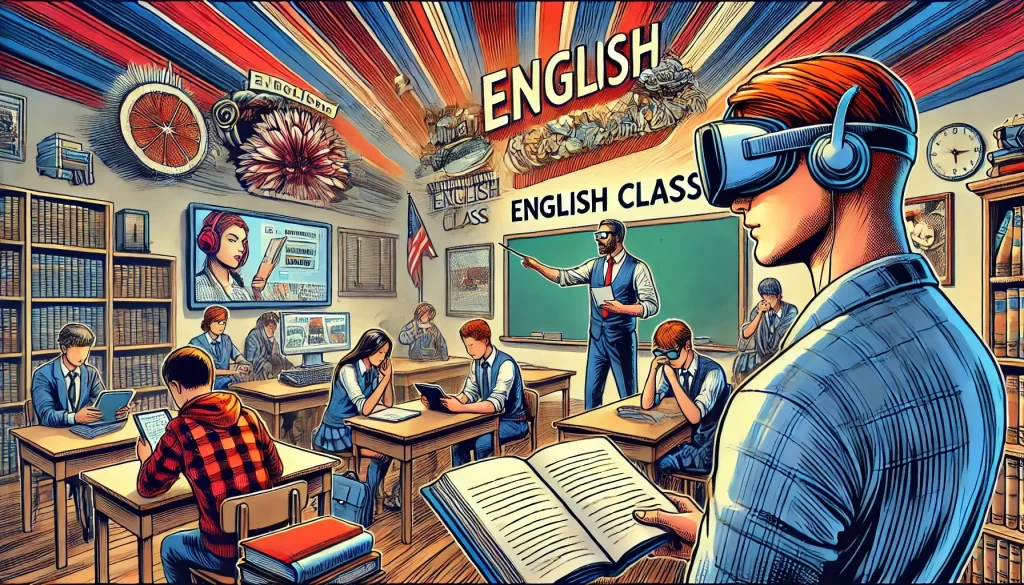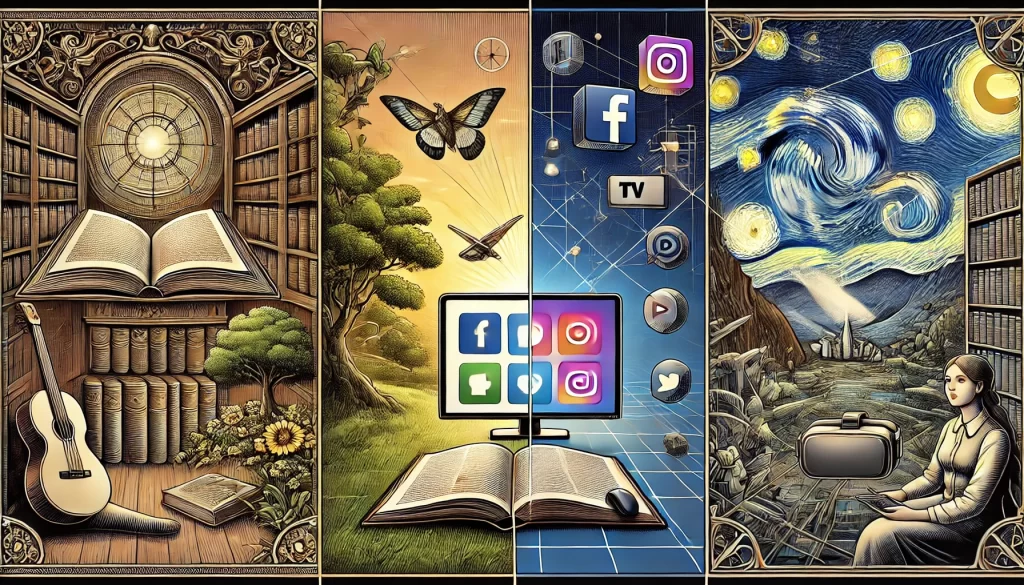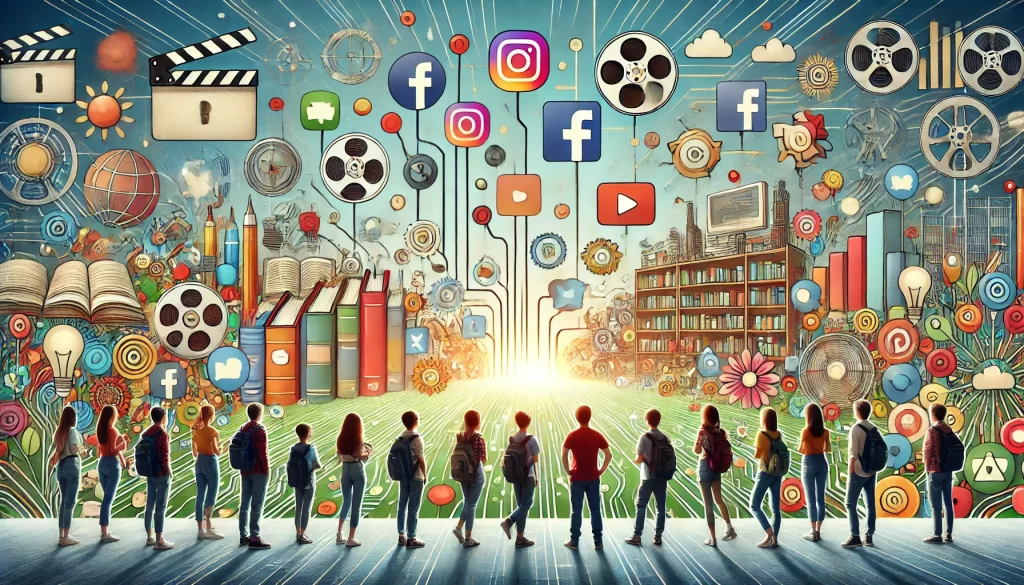Why should we incorporate transmedia storytelling in education? As English educators, we’re all too familiar with the sight of students constantly engaged with their devices, effortlessly switching between various social media platforms and streaming services. While this used to be a source of frustration, I’ve come to see it as an opportunity. What if we could harness this media consumption to enhance our students’ critical thinking skills and make our English lessons more relevant to their daily lives?

Table of Contents
The Evolving Role of English Education
English has always been about more than just Shakespeare and essay writing (though these certainly have their place). In today’s media-saturated world, our discipline serves as a vital toolkit for navigating an increasingly complex information landscape. The skills we teach – critical analysis, effective communication, and thoughtful interpretation – are more crucial than ever.
When we tell our students they’ll need these skills for life, we’re not exaggerating. Whether they’re reading a novel, deciphering social media posts, or analyzing a television series, they’re interacting with texts. Our role is to equip them with the tools to do so critically and thoughtfully.

Recognizing Medium-Specific “Rules”
One of the challenges we face as educators is helping students understand that different media forms have their own sets of rules and conventions. A novel operates differently from a tweet (or what do we call these now that Twitter is “X”?), which in turn is distinct from a television show or a music album. Each medium has its own “recipe for success,” its own ways of engaging audiences and conveying messages.
For instance, a novel allows for deep character development and complex plot structures over hundreds of pages. A tweet, on the other hand, demands concision and often relies on shared cultural knowledge to convey meaning in just 280 characters. A television show like WandaVision can use visual and auditory elements to tell its story, while a concept album like Cowboy Carter can use music, lyrics, and accompanying visuals to create a cohesive narrative experience. This underscores the need for transmedia storytelling in education.
By teaching students to recognize these medium-specific characteristics, we’re helping them become more discerning consumers of media. They learn to adjust their analytical approach based on the type of text they’re encountering, a skill that’s invaluable in our multi-media world.
Universal Communication Goals Across Media
Despite the differences between media forms, it’s fascinating to note that creators across all platforms are typically trying to achieve one or more of three primary goals:
- Persuade
- Inform
- Entertain
I’m sure PIE sounds familiar to you – these goals remain constant whether we’re examining a 19th-century novel, a news article, a TikTok video, or a television series. The methods may change, but the fundamental aims of communication persist.
By helping our students recognize these common threads, we enable them to see patterns and techniques across different media. This not only enhances their analytical skills but also helps them become more effective communicators themselves, able to choose the most appropriate methods to achieve their communication goals in various contexts.
Transmedia Storytelling in Education – Case Study #1: WandaVision
To illustrate how we can apply these concepts in our teaching, let’s consider the Marvel series WandaVision. This show offers a wealth of opportunities for media literacy education.
WandaVision is unique in its structure, with each episode emulating a different era of television history. This allows us to explore how storytelling techniques and visual styles have evolved over time. Moreover, as part of the larger Marvel Cinematic Universe, it provides an excellent example of transmedia storytelling.
Here are some ways we can use WandaVision in our classrooms:
- Analyzing Genre Conventions: Each episode of WandaVision pays homage to a different sitcom era. We can guide students in identifying the characteristic elements of each genre and discussing how these conventions shape the storytelling.
- Exploring Visual Literacy: The show’s changing visual style offers an opportunity to discuss how visual elements contribute to narrative. How does the shift from black-and-white to color affect our perception of the story?
- Discussing Unreliable Narration: The nature of Wanda’s reality in the show provides a perfect springboard for discussions about unreliable narrators and the nature of reality in storytelling.
- Examining Intertextuality: WandaVision is rich with references to other texts, from classic sitcoms to other Marvel properties. This allows us to discuss how texts interact with and inform each other.
- Analyzing Persuasive Techniques: The show’s in-universe commercials offer a chance to discuss persuasive techniques in advertising, especially how they play on the viewers’ emotions and cultural knowledge.
By engaging with WandaVision in these ways, we’re teaching students to apply critical thinking skills to the media they consume in their everyday lives, bridging the gap between classroom learning and real-world application.
Transmedia Storytelling in Education – Case Study #2: Beyoncé’s Cowboy Carter
Beyoncé’s album Cowboy Carter provides another rich text for analysis, offering opportunities to discuss music as a storytelling medium and to explore themes of cultural identity and genre boundaries.
Here are some ways we can incorporate Cowboy Carter into our curriculum:
- Narrative in Music: We can guide students in analyzing how Beyoncé uses music, lyrics, and song order to create a cohesive narrative across the album.
- Exploring Cultural Commentary: The album engages with the history of country music and the experiences of Black artists in the genre. This opens up discussions about cultural appropriation, representation, and the power of art to challenge societal norms.
- Analyzing Transmedia Storytelling: Beyoncé’s album release strategy, including social media teasers and visual elements, provides an excellent case study in how artists use multiple platforms to tell a story and engage their audience.
- Examining Genre Fusion: The album blends country with other genres, allowing us to discuss how artists can push the boundaries of established genres and what this means for artistic expression.
- Discussing Artistic Persona: We can explore how Beyoncé uses this album to reshape her artistic persona, connecting this to discussions about authorial voice in literature.
Analyzing Cowboy Carter can encourage students to engage critically with music and also help them understand how artists use their work to comment on and shape cultural narratives.

Bridging Traditional and Modern Media in the Classroom
While incorporating modern media into our curriculum is crucial, it’s equally important to maintain connections with traditional literary texts. Here are some strategies for bridging the gap:
- Comparative Analysis: Encourage students to draw parallels between themes in classic literature and modern media. For example, how do the themes of identity and perception in WandaVision compare to those in American Born Chinese?
- Adaptive Skills: Teach students to adapt their analytical skills to different media. The close reading techniques used for poetry can be applied to song lyrics or visual symbolism in TV shows.
- Creative Projects: Assign projects that require students to adapt classic works into modern media formats. How might Macbeth unfold as a social media story?
- Transmedia Storytelling: Use examples like the Marvel Cinematic Universe to discuss how modern franchises create complex narrative universes, then draw comparisons to how classic authors built their fictional worlds.
- Media Evolution: Trace how storytelling techniques have evolved from oral traditions through written literature to modern digital media, highlighting both changes and continuities.
By making these connections, we demonstrate the enduring relevance of literary analysis skills while preparing students to engage critically with the media landscape they navigate daily.

Preparing Students for a Multi-Media World
In embracing a multi-media approach to English education, we’re not just teaching students to analyze texts; we’re preparing them to navigate their world more effectively. We’re equipping them with the skills to:
- Question the media they consume
- Think critically about the messages they receive
- Recognize persuasive techniques across platforms
- Understand how medium affects message
- Create and communicate effectively in various formats
These skills are essential in an age where information (and misinformation) is constantly at our fingertips. By teaching students to be savvy, critical consumers of all media, we’re preparing them for success not just in academic settings, but in their personal and professional lives as well.

Conclusion
By expanding our definition of “text” to include modern media forms and teaching students to apply critical thinking skills across platforms, we make our lessons more relevant and impactful.
Incorporating texts like WandaVision and Cowboy Carter alongside traditional literature allows us to bridge the gap between classroom learning and real-world application. It demonstrates that the skills we teach – analysis, interpretation, critical thinking – are not confined to dusty tomes but are vital tools for understanding and engaging with the world.
